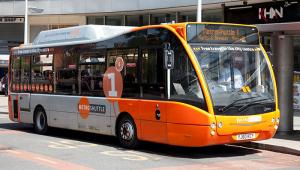07 September 2007
The Comprehensive Spending Review offers the government the chance to grasp the nettle of railway investment and finally set out a long-term transport strategy. It won't come a moment too soon
Overcrowded carriages, interminable delays and crumbling infrastructure are the legacy of decades of stop-start funding and investment in the railways.
The impending Comprehensive Spending Review is a not-to-be-missed opportunity for the government to rectify this neglect. It will set out the overall spending plans for 2008—2011 and decide the strategic direction of transport policy for the next decade.
Transport for London is seeking funding for 'Rail 2025', a series of standalone schemes to increase capacity on crucial suburban commuter routes into London by up to 40%. And we on the London Assembly transport committee are strongly pressing the government to inject the necessary funding.
It is clear that the current network is not being used to its full potential. A report we published in July, Track to the future, explored this in detail. Work on signalling upgrades and extended platforms to allow longer trains is urgently needed.
The committee therefore supports Rail 2025, but we are concerned — as, it appears, is TfL — that it will not be fully funded.
It is also vital for the government to commit to fully funding phase two of the East London Line. This will form an orbital railway around inner London, dramatically improving the transport connections in the south east of the capital. It is another crucial component of the CSR's transport settlement.
If the government is serious about meeting the objectives set out in its July transport white paper, then it is vital that it draws up a mechanism for funding Crossrail in the CSR.
Part of the solution is the need for a more imaginative approach to funding.
The supplementary business rate, proposed by Sir Michael Lyons in his review of local government which was commissioned by Gordon Brown, is an innovative mechanism that could help to square the funding circle.
It would give local authorities the power to implement a business rate levy for specific ring-fenced projects, and could be used by London's boroughs to raise funds for Crossrail.
Delivering a sustainable railway, the government's 30-year plan for the rail network, aims to improve safety and reliability, increase capacity and, crucially, ensure this is funded in a way that is fair to both passengers and taxpayers.
The white paper sets aside funding for projects to tackle congestion on the railways by unblocking bottlenecks, particularly for routes coming into London: 75% of all English train journeys have an origin or destination in London.
This also means that London's rail services can be affected by problems elsewhere — for example, the poorly designed junction at Reading limits the number of trains running per hour into London.
Around £7bn has been earmarked for 'infrastructure enhancements', including increasing capacity at key stations — such as Reading — as well as other small-scale projects.
The capital's train services receive only a tenth of the subsidy allocated to the rest of the country because the large number of passengers means services pay for themselves. However, this is not backed up with funding to maintain the infrastructure, which affects the quality of services both inside and outside the capital.
Alongside funding requirements there needs to be a clear strategy for managing demand on the rail network and promoting a more integrated transport network.
Rail passenger journeys are increasing by about 5% a year. Active measures to control demand are needed. Capacity is finite and travel demand management can ensure demand does not further outstrip supply. It considers likely future travel patterns and how they can be influenced.
This can be done through hard measures such as pricing mechanisms and physical restraints, as well as softer measures, such as making the most efficient use of the transport network. Additional work is needed.
Similarly, more needs to be done to promote an integrated transport network. Sir Rod Eddington's transport study, published late last year, advocated road pricing as part of its analysis of transport's role in supporting the economy.
So far there hasn't been any specific analysis of the potential impact of road pricing schemes on rail.
Decisions about such schemes cannot be made in isolation: the likely consequences of shifts in transport modes must be an integral part of future strategy.
The forthcoming CSR is the government's chance to put in place both the funding and the plans required to make a reality of the aspirations it has set out in its transport white paper.
The committee will argue strongly for it to seize this opportunity.
Geoff Pope is deputy chair of the London Assembly transport committee
PFsep2007



















